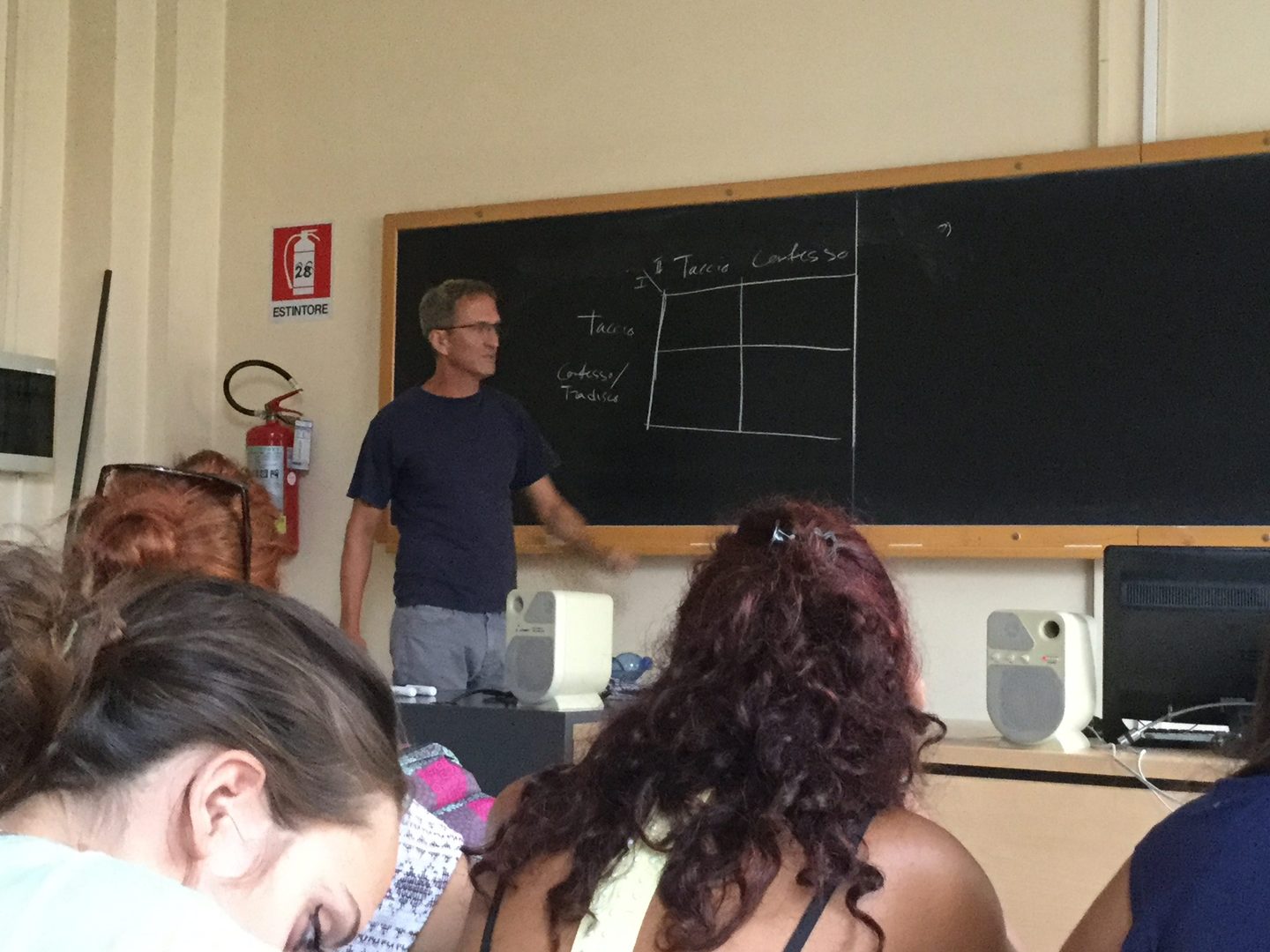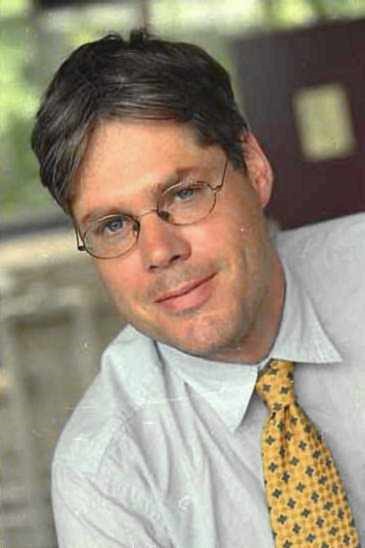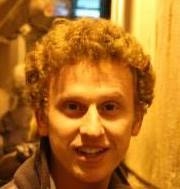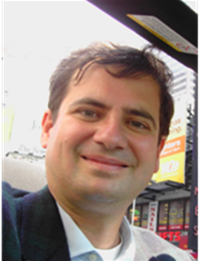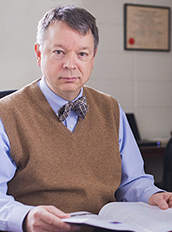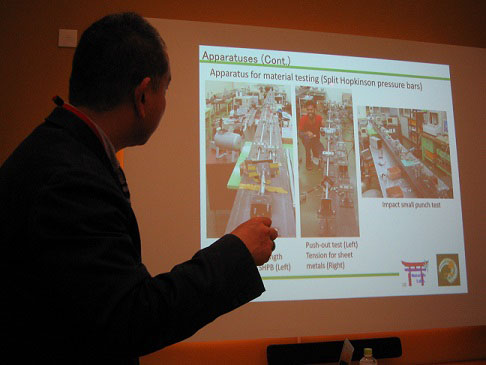FY2017 Annual Report
Mathematics, Mechanics, and Materials Unit
Professor Eliot Fried
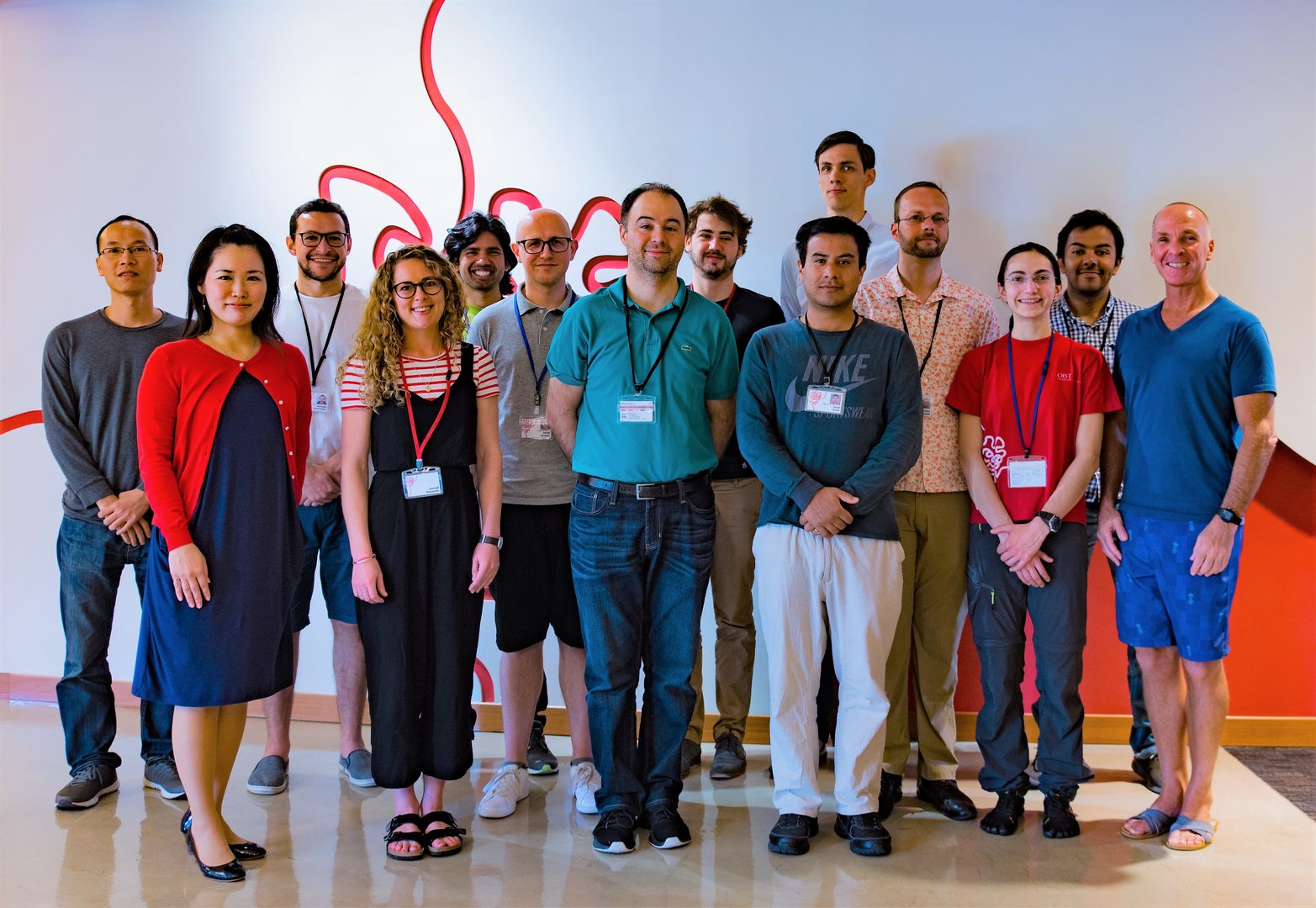
1. Staff
As of March 31, 2018
- Dr. Eliot Fried, Professor
- Dr. Nicolas Moreno Chaparro, Postdoctoral Scholar
- Dr. Wei Chung Chen, Postdoctoral Scholar
- Dr. Alessandro Giussani, Postdoctoral Scholar
- Dr. Tuan Hoang, Postdoctoral Scholar
- Dr. Stoffel Janssens, Postdoctoral Scholar
- Dr. Adel Fernando Sarmiento Rodriguez, Postdoctoral Scholar
- Dr. Johannes Schoenke, Postdoctoral Scholar
- Dr. Alice Clair Tayler, JSPS Postdoctoral Fellow
- Dr. David Vazquez Cortes, Research Unit Technician
- Mr. Michael Grunwald, Research Unit Technician
- Mr. Alexandru Mihai, Graduate Student
- Mr. Vikash Chaurasia, Special Research Student
- Ms. Naoko Tokumoto, Research Unit Administrator
Alumni
- Dr. Ryohei Seto, Group Leader
- Dr. Giulio Giusteri, Postdoctoral Scholar
- Dr. Abdul Majid, Postdoctoral Scholar
- Dr. Yoichi Takato, Postdoctoral Scholar
- Mr. Pak Too Chan, Graduate Student
- Mr. Akira Kawano, Research Intern
- Mr. Manav, Research Intern
2. Collaborations
2.1 Unstretchable two-dimensional materials
- Type of collaboration: Joint research
- Researchers:
- Professor Yi-Chao Chen, University of Houston, Houston, TX, USA
- Professor Roger Fosdick, University of Minnesota, Minneapolis, MN, USA
2.2 Fabrication of diamond-based surface-acoustic-wave devices
- Type of collaboration: Joint research
- Researchers:
- Professor Satoshi Fujii, Okinawa National College of Technology, Naha, Okinawa, JAPAN
- Professor Satoshi Fujii, Okinawa National College of Technology, Naha, Okinawa, JAPAN
3. Activities and Findings
3.1 Möbius Kaleidocycle Puzzle
Known tetrahedral rings made from more than seven tetrahedra can deform in many different ways and moves in what might be described as a “snakelike” fashion, which is quite visually unappealing and has no functional benefit. This invention is based on a family of yet unknown ring mechanisms made from identical twisted tetrahedra. For a given critical twist angle based on the number of tetrahedra, the
ring mechanism only has one single degree of freedom. This allows for the placement of intricate periodic patterns on the facets of the tetrahedra whereby parts of these patterns become periodically visible/hidden during the everting motion of the ring.
3.2 Contactless Magnetic Couplings for Microfluidic Devices and Nautical Propulsion
Magnetic gears have many advantages over mechanical gears. They are contactless and therefore not subject to mechanical wear. They need no lubrication and less maintenance than ordinary gears. They also exhibit inherent overload protection, are noiseless and highly reliable, and allow for the physical isolation of input and output. After the theoretical discovery of a new magnetic gear concept we developed a prototype car and filed a patent for "Contactless Magnetic Couplings for Microfluidic Devices and Nautical Propulsion", application number US 15/846,565.
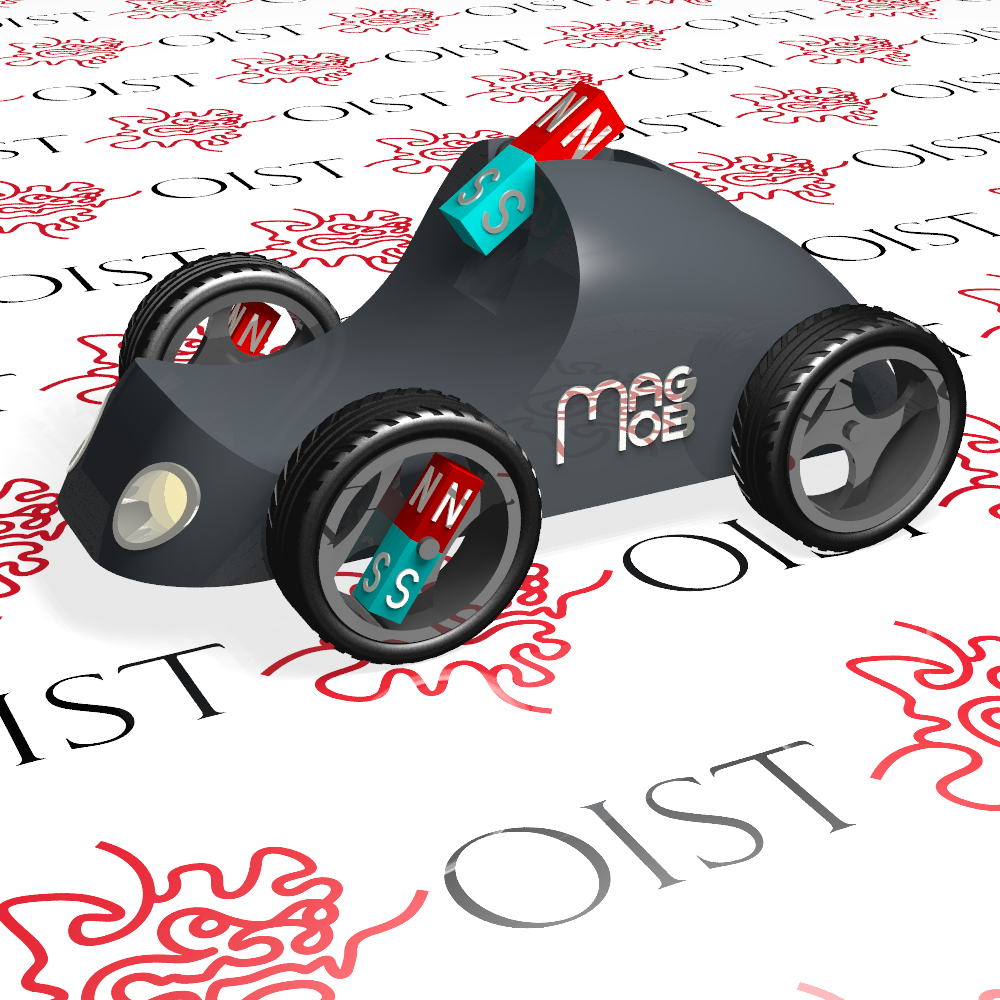
3.3 Computational design of functional materials: Self-assembly of soft-patchy nanoparticles
The assembly of soft-patchy nanoparticles emerges as a major breakthrough in the design functional and stimuli-responsive materials[1,2]. The control of the morphology, mechanical and physicochemical stability of the assemblies is crucial to ensure the robustness of the fabrication process. In general, since the soft-patchy nanoparticles can deform (or undergo internal rearrangements), the complexity of their assemblies is higher than those obtained from the aggregation of rigid particles. Despite their potential in different industrial applications, the aggregation of soft-patchy nanoparticles is not well understood, and theoretical investigations are scarce. Here we use computational models to study the interplay between the anisotropic interactions and the deformability of the nanoparticles.
3.4 Design of patchy nanoparticles via the self-assembly of triblock terpolymers in selective solvents
The hierarchical self-assembly of triblock terpolymers in solution is a successful bottom-up methodology to construct functional patchy nanoparticles with prescribed topology and shape. Currently, the design of such nanoparticles requires an iterative process to identify the proper experimental phase parameters to produce a particular type of pattern. Thus, the broad use of this technology is still cumbersome due to the lack of understanding about the mechanism of patch transition as the system conditions vary. The critical balance between thermodynamics and kinetics governing the topology of the assemblies is still elusive.
Here, we present a set of rules to program desired shapes on the nanoparticles and predict their assembly. We investigate systematically the interplay between entropic and enthalpic parameters governing the self-assembly of ABC triblock copolymers in a selective solvent for the C block. We use computational modeling at mesoscale, such that we can represent the length and time scales associated with the motion and assembly of the polymer coils, while approximate the chemically driven interactions. The phase diagram predicted by our computational model is consistent with the characteristic micelle shapes experimentally identified. We show that the effective volume fraction of the soluble block determines the size of the micelles and the distribution of the patches via steric interactions, whereas the relative fraction of the patch-forming block and its affinity with the core of the nanoparticles dictates the amount and shape of the patches. As a major outcome, we construct a morphological-based library of micelles, that can be used to hierarchically design mesoscale aggregates with a prescribed shape. Our results provide new insights into the intriguing mechanism driving the morphology nanoscale objects, for synthetic and biological systems.
4. Publications
4.1 Journals
- Y.-C. Chen, R. Fosdick, E. Fried, Representation of a smooth isometric deformation of a planar material region into a curved surface, Journal of Elasticity 130 (2018), 145–195. (doi:10.1007/s10659-017-9637-2).
- G.G. Giusteri, P. Podio-Guidugli, E. Fried, Continuum balances from extended Hamiltonian dynamics, Journal of Chemical Physics 146 (2017), 224102. (doi:10.1063/1.4984823).
- C. Peco, W. Chen, Y. Liu, M.M. Bandi, J. Dolbow, E. Fried, Influence of surface tension in the surfactant-driven fracture of particulate monolayers, Soft Matter 15 (2017), 5832–5841. (doi:10.1039/c7sm01245d)
- S.D. Janssens, V. Chaurasia, E. Fried, Effect of surface tension imbalance on a partly submerged cylinder, Journal of Fluid Mechanics 830 (2017), 369–386. (doi:10.1017/jfm.2017.537)
- A. Panchenko, D. Hinz, E. Fried. Spatial averaging of a dissipative particle dynamics model for active suspensions, Physics of Fluids 30 (2018), 033301-1–21. (doi:10.1063/1.5024746)
4.2 Books and other one-time publications
Nothing to report
4.3 Oral and Poster Presentations
- G. G. Giustri, Mathematical modeling and characterization of non-Newtonian viscous fluids, 54th Mathematical Analysis Seminar, Kanazawa University, Japan, April 14 (2017).
- N. Moreno, E. Fried, Hierarchical self-assembly of triblock terpolymers, 5th International symposium frontiers in polymer Science, Seville, Spain, May 17 (2017).
- R. Seto, Constitutive characterization of concentrated particle suspensions, IUTAM/AMERIMECH SYMPOSIUM Computational Mechanics of Particle-Functionalized Fluid and Solid Materials for Additive, Berkeley, USA, May 31 (2017).
- R. Seto, Mathematical Soft Matter Unit, Okinawa Institute of Science and Technology, Seminar, Tokyo University, Tokyo, Japan, July 3 (2017)
- R. Seto, Simulation model for dense suspension rheology: Stokesian-DEM, Rheology Minisymposium, Tokyo University, Chiba, Japan, July 4 (2017)
- S. D. Janssens, V. Chaurasia, E. Fried, Marangoni propulsion at curved interfaces, Next Generation of Optimists, NIMS, Ibaraki, Japan, August 1 (2017)
- E. Fried, Marangoni propulsion on liquid surfaces: experiments and theory, Seminar, Queen's University, Kingston, Canada, September 7 (2017)
- E. Fried, Importance and effectiveness of representing the shapes of Cosserat rods and framed curves as paths in the special Euclidean algebra, Seminar, McGill University, Montreal, Canada, September 11 (2017).
- R. Seto, Shear thickening and jamming transition under extensional ows, JPS the 2017 Autumn Meeting, Iwate University, Iwate, Japan, September 21 (2017)
- R. Seto, G. G. Giusteri, Non-Newtonian fluid behavior of dense suspensions in simple shear and extensional flows, 89th Annual Meeting, The Society of Rheology, Embassy Suites Denver Downtown, Denver, Colorado, USA, October 9 (2017)
- E. Fried, Shape selection induced by competition between surface and line energy, Seminar, Colorado State University, Colorado, USA, October 12 (2017)
- G. G. Giusteri, R. Seto, A theoretical framework for steady-state rheometry in generic flow conditions, 89th Annual Meeting, The Society of Rheology, Embassy Suites Denver Downtown, Denver, Colorado, USA, October 12 (2017)
- E. Fried, Shape selection induced by competition between surface and line energy, Seminar, Colorado School of Mines, Colorado, USA, October 13 (2017)
- E. Fried, Isogeometric phase-field analysis, Seminar, University of Colorado, Boulder, Colorado, USA, October 16 (2017)
- R. Seto, G. G. Giusteri, Toward a fluid mechanical model of shear thickening dense suspensions, 65th Rheology Meeting, Toki Messe, Niigata Convention Center, Niigata, Japan, October 18 (2017)
- Y. Takato, E. Fried, Molecular dynamics study of graphene mobius bands: Equilibrium shapes and energies, 13th International Conference and Exhibition on Advanced Materials and Nanotechnology, Osaka, Japan, October 27 (2017)
- E. Fried, The shape, energy, and stability of Graphene Möbius bands, Seminar, Korea Advanced Institute of Science and Technology (KAIST), Daejeon, Republic of Korea, October 24 (2017)
- E. Fried, The shape, energy, and stability of Graphene Möbius bands, Seminar, University of Houston, Houston, USA, November 3 (2017)
- R. Seto, Rheology of particle dispersions, Seminar, Asahi Glass Co., Ltd, Tokyo, Japan, November 16 (2017)
- E. Fried, Dimensionally reduced energy and equilibrium conditions for an isometrically deformed, Seminar, Sapienza Universita di Roma, November 22 (2017)
- R. Seto, G. G. Giusteri, コロイド分散系の伸長流レオロジー, 31st Morecular Simulation society meeting, The Kanazawa Chamber of Commerce and Industry, Kanazawa, Ishikawa, Japan, November 29 (2017)
- E. Fried, Isogeometric phase-field analysis, MIMS Workshop, Meiji University, Tokyo, Japan, December 5 (2017)
- R. Seto, How dense suspensions flow? - Non-equilibrium microstructure and frictional contacts, Seminar, Waseda University, Tokyo, Japan, December 19 (2017)
- R. Seto, G. G. Giusteri, Introduction of general rheology functions based on stress tensor decomposition, 鳥取非線形研究会2017, Tottori University, Tottori, Japan, December 20 (2017)
- R. Seto, How dense suspensions flow? - Non-equilibrium microstructure and frictional contacts, Seminar, Osaka University, Osaka, Japan, December 22 (2017)
- V. Chaurasia, Y-C. Chen, E. Fried, Interacting elastic curves constrained on a rigid sphere, Joint Mathematics Meetings 2018, American Mathematical Society, San Diego, USA, January 12 (2018)
- J. Schoenke, New Contactless Magnetic Couplings for Applications in Microfluidics, Renewable Energy, and Nautical Propulsion, New Technology Presentation Meetings, JST, Tokyo, Japan, February 27 (2018)
- E. Fried, Shape transitions of discoidal high-density lipoprotein particles, Seminar, MAT theater at JAMSTEC, Yokohama, Kanagawa, Japan, February 28 (2018)
- E. Fried, Shape selection induced by competition between surface and line energy, Seminar, Mathematics & Statistics Colloquium, University of San Francisco, USA, March 7 (2018)
- E. Fried, Kaleidocycles and Möbius bands, Seminar, Mathematics and Statistics Colloquium, San Jose State University, USA, March 14 (2018)
5. Intellectual Property Rights and Other Specific Achievements
Nothing to report
6. Meetings and Events
6.1 Seminars
Professor Paolo Cermelli (Department of Mathematics, University of Torino, Italy)
- Date: May 17, 2017
- Venue: C016, Lab 1 , OIST Campus
- Seminar: Energy cascades in conformational changes of viral capsids
Professor Maurice van Putten (Sejong University, Seoul, Republic of Korea)
- Date: July 19, 2017
- Venue: C209, Center building, OIST Campus
- Seminar: Some new directions in cosmology and astrophysics
Professor Toshiyuki Ogawa (Meiji University, Tokyo, Japan)
- Date: October 20, 2017
- Venue: C015, Lab 1, OIST Campus
- Seminar: Rippling rectangular waves for a modified Benney equation
Professor Daniel Spector (National Chiao Tung University (NCTU), Taiwan)
- Date: January 18, 2018
- Venue: C016, Lab 1, OIST Campus
- Seminar: A sharp inequality of J. Moser for higher order derivatives
Professor Gianni Royer-Carfagni (Department of Engineering and Architecture, University of Parma, Italy)
- Date: January 31, 2018
- Venue: D015, Lab 1 , OIST Campus
- Seminar: A phase-field approach to structured plastic deformations
Professor A. Jeffrey Giacomin (Chemical Engineering, Queen's University, Canada)
- Date: February 21, 2018
- Venue: C016, Lab 1 , OIST Campus
- Seminar: Oscillatory Shear Testing: Amplitudes Large and Small
Professor Wolfgang Bangerth (Department of Mathematics, Colorado State University, US)
- Date: March 5, 2018
- Venue: C016, Lab 1 , OIST Campus
- Seminar: Simulating complex flows in the Earth mantle
Professor Takeshi Iwamoto (Academy of Science and Technology, Hiroshima University, Japan)
- Date: March 27, 2018
- Venue: C016, Lab 1 , OIST Campus
- Seminar: Recent progress on an estimation of rate sensitivity in the metallic materials with mechanically-induced phase transition and its related topics
Professor Anasavarapu Srikantha Phani (Associate Professor of Department of Mechanical Engineering, The University of British Columbia, Canada)
- Date: March 28, 2018
- Venue: C016, Lab 1 , OIST Campus
- Seminar: Waves in lattices — opportunities and challenges
6.2 Events
6.2.1 Spring Course: HMM 2017, April 3 - 8, 2017
- Date: April 3 - 8, 2017
- Venue: OIST Conference Center
- Lecturer:
- Sara Bonella, Ecole Polytechnique Fédérale de Lausanne
- Giovanni Ciccotti, Sapienza — Università di Roma
- Antonio DiCarlo, CECAM—IT—SIMUL Node
- Paolo Podio-Guidugli, Accademia Nazionale dei Lincei
6.2.2 CoMFoS 2017, September 20 - 22, 2017
International Conference CoMFoS17: Mathematical Analysis of Continuum Mechanics
- Date: September 20 - 22, 2017
- Venue: OIST Seaside House
- Co-organizers:
- Masato Kimura, Kanazawa University
- Mahesh Bandi, OIST
- Organizing Committee:
- Shiro Hirano, Ritsumeikan University
- Hiromichi Ito, Tokyo University of Science
- Naoshi Nishimura, Kyoto University
- Hirofumi Notsu, Kanazawa University
- Kohji Ohtsuka, Hiroshima Kokusai Gakuin University
- Akira Takada, Asahi Glass Co., Ltd.
- Takeshi Takaishi, Hiroshima Kokusai Gakuin University
6.2.3 Diamond Workshop 2017, October 29 - November 1
- Date: October 29 - November 1, 2017
- Venue: OIST Seminar House
- Co-organizers:
- Satoshi Koizumi, NIMS
- Julien Pernot, Institut Néel-CNRS, UGA
7. Other
Nothing to report.




